CUMI’s Kool Blu series grinding wheels redefines the high module gear grinding process with high material removal and no burn
Xavier Kennedy, General Manager – Head of R&D, CUMI
Abstract:
In the recent years, wind power energy has gained wider acceptance as a solution to reduce emissions and thus reduce global warming. The growth of wind power technology is driven by larger wind turbines and gearboxes. The increasing demands on a higher reliability and low maintenance cost of the gear boxes requires new production methods to grind the gears to a high degree of profile integrity and surface quality. This article showcases the newest developments from CUMI in this rapidly growing field.
Gears for Wind power energy:
A Gearbox is typically used to increase the rotational speed from a low to higher speed electrical generator. Designing a wind turbine gearbox is challenging due to the loading and environmental conditions in which the gear box has to operate. Gears used in wind turbines need to transfer high loads and possess accurate geometry. High load transfer demands hardened materials for this application. Due to the ongoing boom in the wind energy market, gearbox manufacturers are focusing on increasing the capacity and productivity of existing machine tools. In profile grinding, the total cycle time to grind a gear consists of idle time and main production time.
In gear or profile grinding, the cycle time to grind gear is vital on overall productivity of the machine. Generally the cycle time consists of idle or free run time and production time. Optimization of the grinding cycle involves significant impact in the production time. The grinding time is calculated as specific material removal rate, Q’w. It represents the output of the grinding process. Q’w has to be increased to reduce the grinding time. Higher the specific material removal rate lesser the grinding time. Q’w is the product of radial in-feed and axial feed. Grinding time shall be increased either by larger radial infeed or faster axial feed speed or even both. The limiting factor for the change is the profile accuracy and grind burn.
Specific material removal rate Q’w
This value represents the cutting capacity of the given wheel in terms of volumetric material removed (in mm3), per mm of grinding wheel width per second. This is expressed as mm3/mm/sec. Q’w is widely accepted as a benchmarking parameter to define the process and performance level of the abrasive tool. It is calculated by formula given in equation 1:
Q’w = a e V w /60 (Eq.1)
Where ae depth of cut, is taken as vertical infeed into the tool gap. Vw specific chip volume. It refers to the volume of material removed until redressing is initiated. The flip side of a high Q’w is the generation of high heat during the grinding process and consequent burn damage to the gear.
Any significant change in Q’w demands specific change in the grinding wheel design which can address the potential mechanical and metallurgical damages to the work piece. The three major components of the grinding wheel, Abrasive, bond and pores, play an important role to improve the specific material removal rate.
CUMI’s constant innovation and product up gradation, through in-house R&D and strategic alliances with global leaders in grinding technology, have ensured international recognition as a manufacturer of quality abrasives and a provider of total grinding solutions. At CUMI’s state of art facility, the design and manufacture of a grinding wheel with micro crystalline abrasives, advanced profile making, breakthrough ceramic bond designs and robust manufacturing practices, all come together under one roof for the development and production of the next generation wheels
Kool blu series wheels for higher Q’w:
CUMI’s engineered abrasives with defined geometry coupled with functional bonds helps in achieving high Q’w. These engineered grains are not only tough but have low bulk density. The uniqueness of shape and distribution gives more interconnected porosity and good accessibility of coolants to grinding zone.
High level of porosity ensure uniform swarf removal. These next generation wheels increase the throughput, offer significant reduction in wheel dressing frequency, minimizes the possibility of grinding burn and yield reliable and consistent grinding performance.
These wheels also have high permeability which improves the coolant carrying capacity of the wheel to the grinding zone. The combination of above properties makes it a perfect solution for this demanding application.
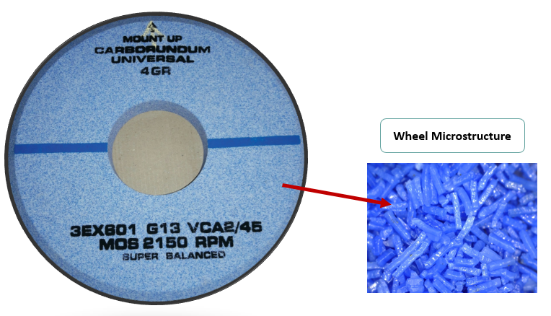
Figure 1:
Kool blu series wheels best suited for high stock removal without grinding burn.
Case History:
To elaborate the performance of Kool blu series wheels, two case histories have been shown pertaining to windmill gear grinding applications. Kool blu wheels outperformed the standard sol gel wheel by factor of >2. It resulted in higher Vw and substantial reduction in grinding cycle time. Fig 2 and 3 shows the gears finished with Kool blu series of wheels with respective case history. Kool blu series wheels enable higher specific material removal without affecting the dimensional accuracy of the gears (Figure 4 and 5).
| Case History : Gear grinding | ||
| Gear Data | ||
| Material | BS7211963, Hard State | |
| Module | 10 | |
| Number of teeth | 16 | |
| Face width mm | 47.3 | |
| Helix angle ß | 20 | |
| Performance | ||
| Wheel | Reference | CUMI EX |
| Machine power (kW) | ||
| Feed-rate Vw’ (mm/min) | 1200 | 1500 |
| Infeed ae (mm) | 0.38 | 0.73 |
| Specific Material removal rate Q’w | 8 | 18 |
| Surface finish Ra | 0.7 | 0.45 |
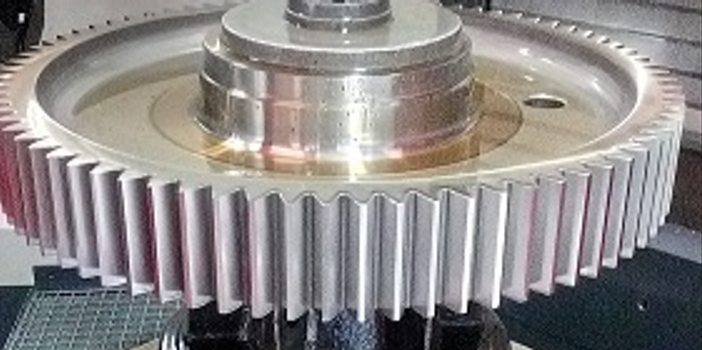
| Case History : Gear grinding | ||
| Gear Data | ||
| Material | SAE/AISI /8822H Hard State | |
| Module | 6 | |
| Number of teeth | 56 | |
| Face width | 80mm | |
| Helix angle ß | 20 | |
| Performance | ||
| Wheel | Reference | CUMI EX |
| Machine power (kW) | ||
| Feed-rate Vw’ (mm/min) | 1200 | 2000 |
| Infeed ae (mm) | 0.133 | 0.336 |
| Specific Material removal rate Q’w | 4 | 10 |
| Surface finish Ra | 0.7 | 0.6 |
Case History 2
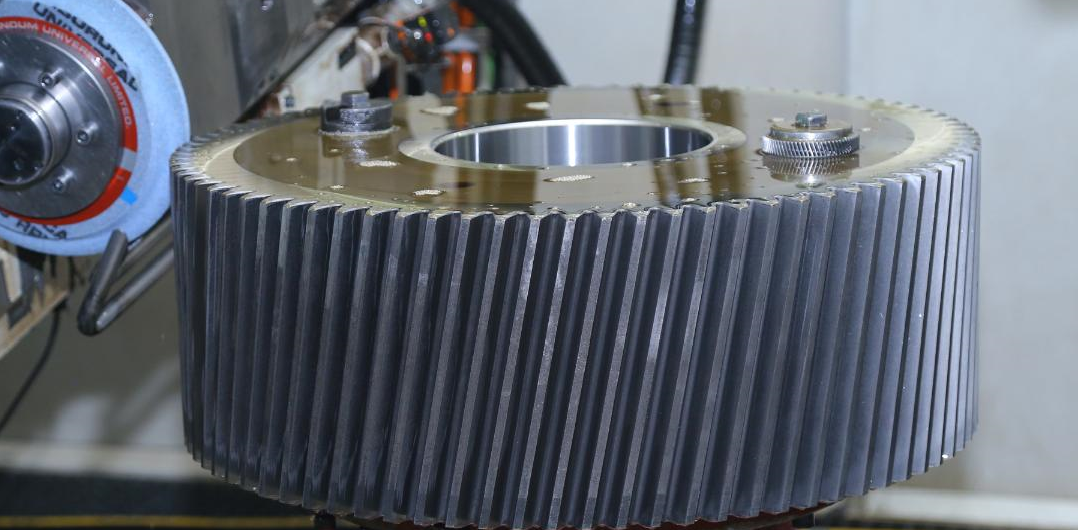
Figure 3
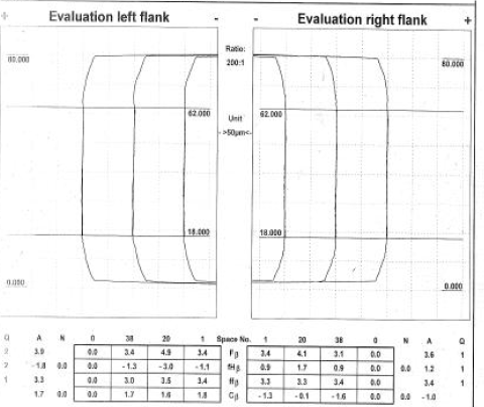
Figure 4: Lead
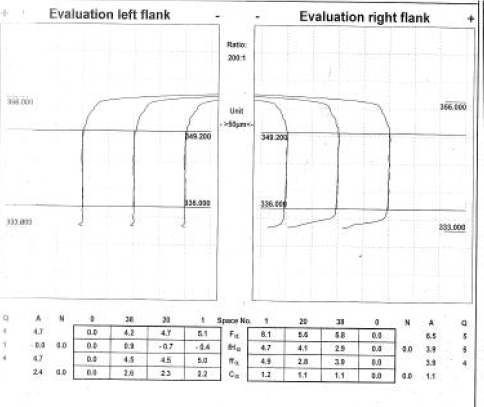
Figure 5: Profile
Conclusion:
Kool blu series wheels demonstrate exceptional performance in gear grinding with single rib wheels, and also in other profile grinding applications. Kool blu series wheels are set to take productivity to a very high order while reducing the risk of thermal damage.
Reference:
- Statistisches Bundesamt/VDMA.
- Klaiber, M., Aktuelle Marktentwicklung bei In dustriegetrieben, Lehrgang Praxis der Zahn radfertigung, Technische, Akademie Esslingen, 2007.
- Schlattmeier, H., Diskontinuierliches, Zahnfl an kenprofi lschleifen mit Korund, Dissertation, RWTH Aachen, 2003.
- Vuèetiæ, D., Signifi kante Produktivitätssteiger, ung beim Schleifen, großer Moduln durch Kom bination, von Prozessen, Seminar Feinbearbeitung, von Zahnrädern, WZL der RWTH Aachen 2007.
- Reichel, F., Verfahrensauswahl, beim Schleifen von Großverzahnungen, Seminar Feinbearbeitung von Zahnrädern, WZL der RWTH Aachen 200.
- Innovative Concepts for Grinding Wind Power Energy Gears, A. Türich, C. Kobialka, and D. Vucetic, www.geartechnology.com/issues/0609.
